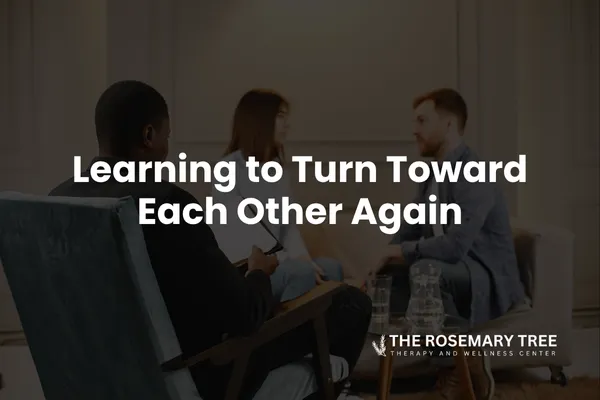
Learning to Turn Toward Each Other Again
When Connection Feels Distant
After betrayal, couples often describe the same feeling, distance. Conversations feel shallow, touch feels uncertain, and moments that once brought joy now feel heavy. Even when both people want to reconnect, fear and tension can get in the way.
The good news is that reconnection rarely happens in big, dramatic gestures. It happens in small moments, when two people learn to turn toward each other again.
What It Means to “Turn Toward”
Turning toward your partner means responding with care when they reach out emotionally or physically. It could be a sigh, a question, a glance, or a request for help, each is an invitation for connection.
Every time you turn toward instead of away, you build a tiny moment of trust. Over time, these moments become the building blocks of safety.
Examples include:
Responding when your partner shares something small about their day
Making eye contact instead of looking at your phone
Offering comfort when they seem stressed or quiet
Expressing gratitude for small efforts, even if things are still hard
When couples consistently turn toward each other, they begin to repair the sense of “we” that betrayal often destroys.
Why It’s Hard to Reconnect
After a rupture, both partners may feel hesitant to reach out. The betrayed partner fears rejection or insincerity. The partner who caused harm fears being met with anger or rejection.
These fears create silence, and silence strengthens disconnection.
Healing begins when both people choose to reach, respond, and remain present, even when it feels uncomfortable.
The Power of Small Moments
Connection is not built in therapy sessions alone. It’s built in the quiet, everyday moments that happen between them.
Here are small, practical ways to begin turning toward your partner again:
Notice Their Bids for Connection
A sigh, a question, or even a shared glance can be a request for attention or comfort. Respond, even in small ways.Show Appreciation Often
Express gratitude for their efforts, no matter how small. Appreciation lowers defensiveness and increases warmth.Check In Daily
Ask, “How are you feeling today?” without an agenda. Listening without fixing builds safety.Use Gentle Touch When Appropriate
Touch can be powerful, but only when it feels safe for both. Start small, a hand on the shoulder, a light hug, or sitting close.Create Shared Rituals
Coffee together in the morning, a nightly walk, or a weekly moment of gratitude. Predictable moments create emotional stability.
Why Turning Toward Restores Attachment
Attachment is strengthened through responsiveness, when one partner reaches and the other responds. It is not about solving problems, but showing up.
When your partner feels heard, seen, and cared for, their nervous system relaxes. When you feel accepted and trusted, yours does too.
This mutual regulation rebuilds emotional safety, the foundation of all intimacy.
How Therapy Intensives Support Reconnection
Rebuilding closeness after betrayal often takes more than conversation. It requires guided practice, emotional regulation, and time to rebuild trust through consistent interaction.
Our Accelerated Deep-Work Therapy Intensives give couples the dedicated space to:
Relearn emotional connection through guided exercises
Practice safe touch and shared presence
Understand each other’s attachment needs
Replace defensive habits with responsive ones
Create a personalized plan for staying connected after the intensive
When couples are supported in these ways, they begin to remember what safety and warmth can feel like again.
When Reconnection Feels Scary
It’s normal to hesitate. After betrayal, closeness can feel risky, even when you love each other. That fear does not mean you are broken, it means your body is still protecting you.
Take it slow. Small, steady moments of connection will do far more for healing than forcing emotional or physical intimacy too soon.
Final Thoughts
Turning toward each other is the everyday act of saying, “We’re still here.” It’s how couples rebuild after everything feels lost, not through perfection, but through presence.
If you and your partner are ready to begin reconnecting in a safe and guided way, we would love to help. You can reach out to us here, and our team will connect with you to talk about what this process could look like. There is no pressure, only care and support as you take the next step together.
